The Gulf of Mexico isn’t just a hotspot for sunbathers and surfers. It’s also a shark wonderland! Some of them are friendly, others, well, not so much.
As we take a deep dive into their world, we’ll share all there is about the shark species that call this place home, plus some safety tips and tricks on what to do if you ever encounter them.
So without further ado, let’s meet the sharks of the Gulf.
The Gulf of Mexico: Nature’s Shark Paradise
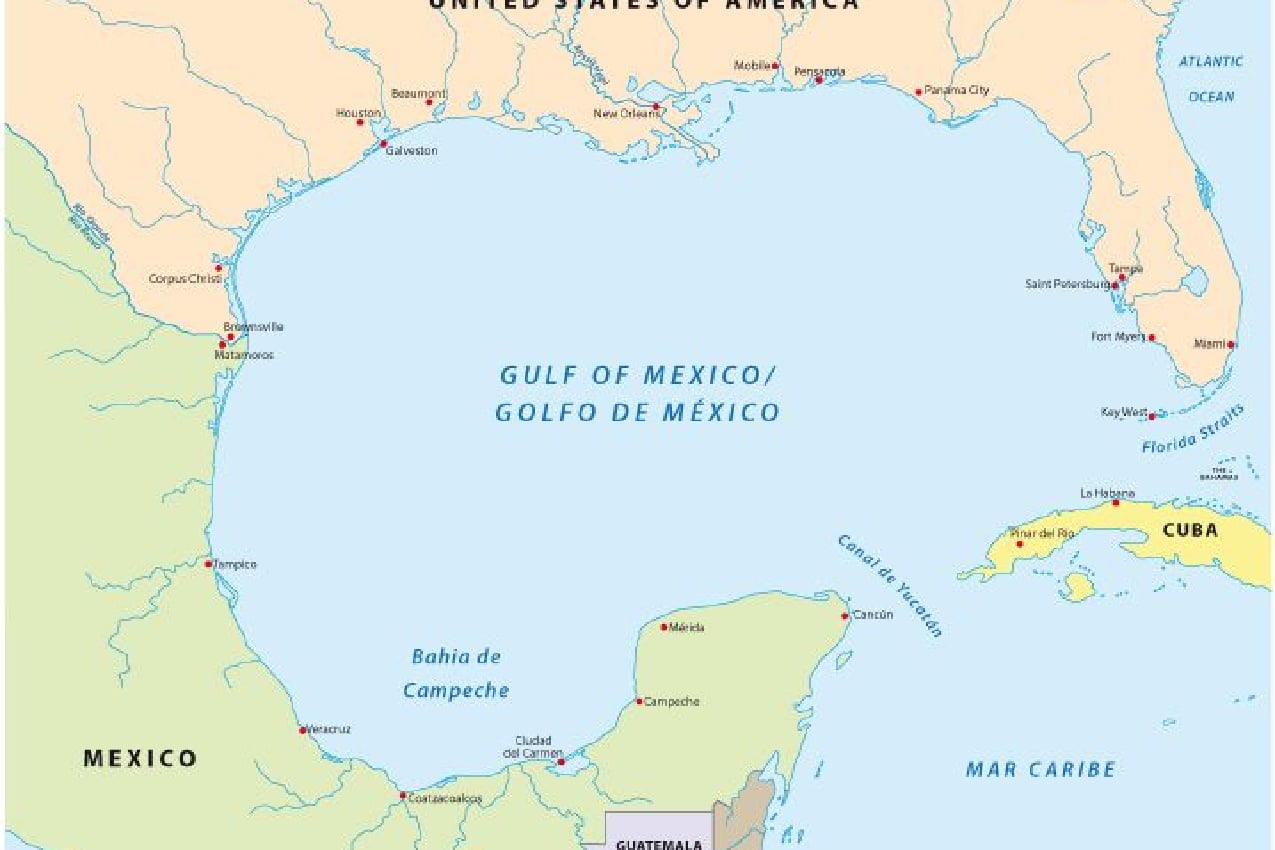
The Gulf of Mexico is 300 million years old. It covers a whopping 600,000 square miles (1.55 million square kilometers), making it the 9th largest body of water in the world, so it’s brimming with marine life.
The Gulf neighbors Cuba, the Mexican states of Quintana Roo, Campeche, Tamaulipas, Yucatán, Veracruz, and Tabasco, and the U.S. states of Florida, Alabama, Texas, Louisiana, and Mississippi.
The Gulf also has well-connected water floors. The Florida Straits connect it to the vast Atlantic Ocean, and the Yucatan Channel connects it to the Caribbean Sea. Here to join the aquatic party are also eight rivers, the Mississippi River and the Rio Grande being the most notable.
List of Sharks in the Gulf of Mexico
- Bull Shark
- Thresher Shark
- Hammerhead Shark
- Blacktip Shark
- Whitetip Shark
- Mako Shark
- Nurse Shark
- Lemon Shark
- Silky Shark
- Tiger Shark
- Sandbar Shark
- Blacknose Shark
- Finetooth Shark
- Smooth-hound Shark
- Caribbean Sharpnose Shark
- Caribbean Reef Shark
- Galapagos Shark
- Spotted Ragged-tooth Shark
- Great White Shark
- Spinner Shark
- Blue Shark
- Dusky Shark
- Whale Shark
- Basking Shark
- Greenland Shark
The Gulf of Mexico has an average depth of roughly 5,298ft (1614m) and is home to approximately 24 different shark species.
Bull Shark
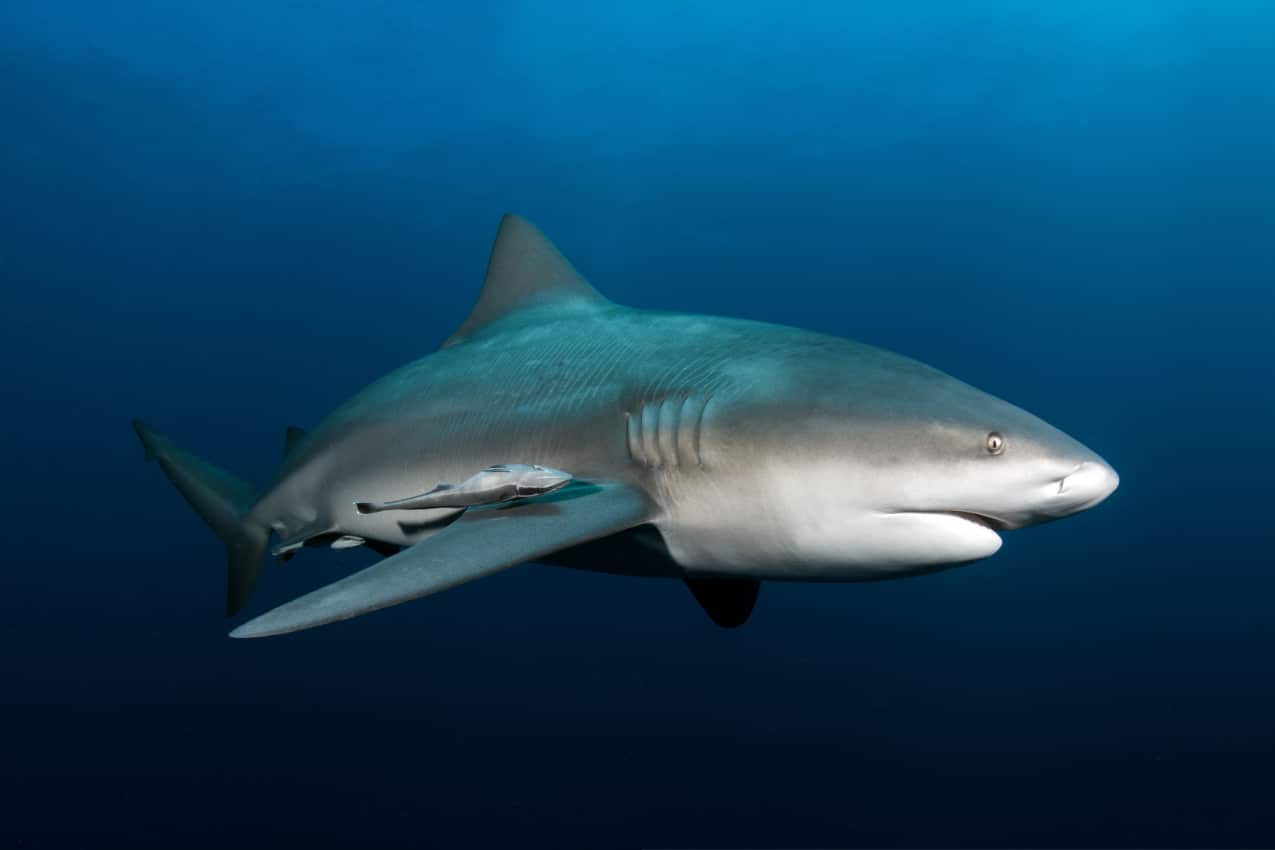
Bull sharks, like the bulls they’re named after, are aggressive and known to headbutt prey before biting. They have small snouts, which also make them look like bulls.
Bull sharks flourish in fresh and saltwater and can eat anything from fish, turtles, dolphins, and other sharks. They are medium-sized, with their average length ranging from 7 to 11ft (2.1 to 3.4m). Keep an eye on these because they enjoy cruising in shallow water when looking for food.
Thresher Shark
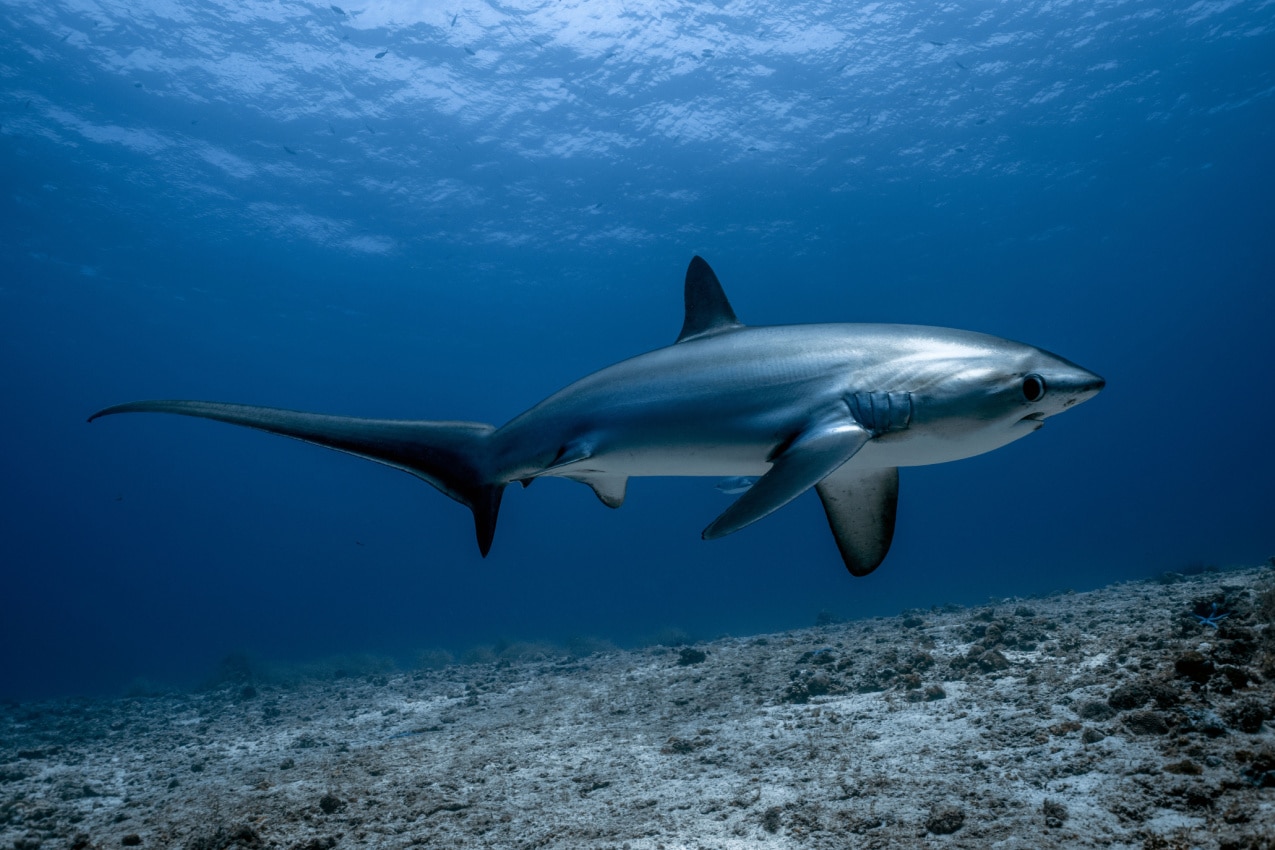
Thresher sharks are very peculiar. First, their faces look like they’re always shocked. Second, they have a tremendously long upper tail fin that resembles a scythe.
They use their long tail as a hitting tool to stun fish and squids — their favorite meals. They’re also big, reaching up to 15ft (4.5m) in length. Despite their size, they’re shy species and don’t have a tendency to attack humans. So, if you spot one, it will probably be way too uncertain to do anything but look at you from a distance!
Hammerhead Shark

Hammerheads are one species we all recognize — thanks to their recognizable hammerhead-shaped head, also known as the cephalofoil. The Great Hammerhead is the biggest of the hammerhead species, reaching sizes of up to 20ft (6m).
The menu of this species consists of fish, squid, rays, and smaller sharks. Despite their intimidating look, they’re generally shy and non-aggressive when they encounter humans.
Blacktip Shark
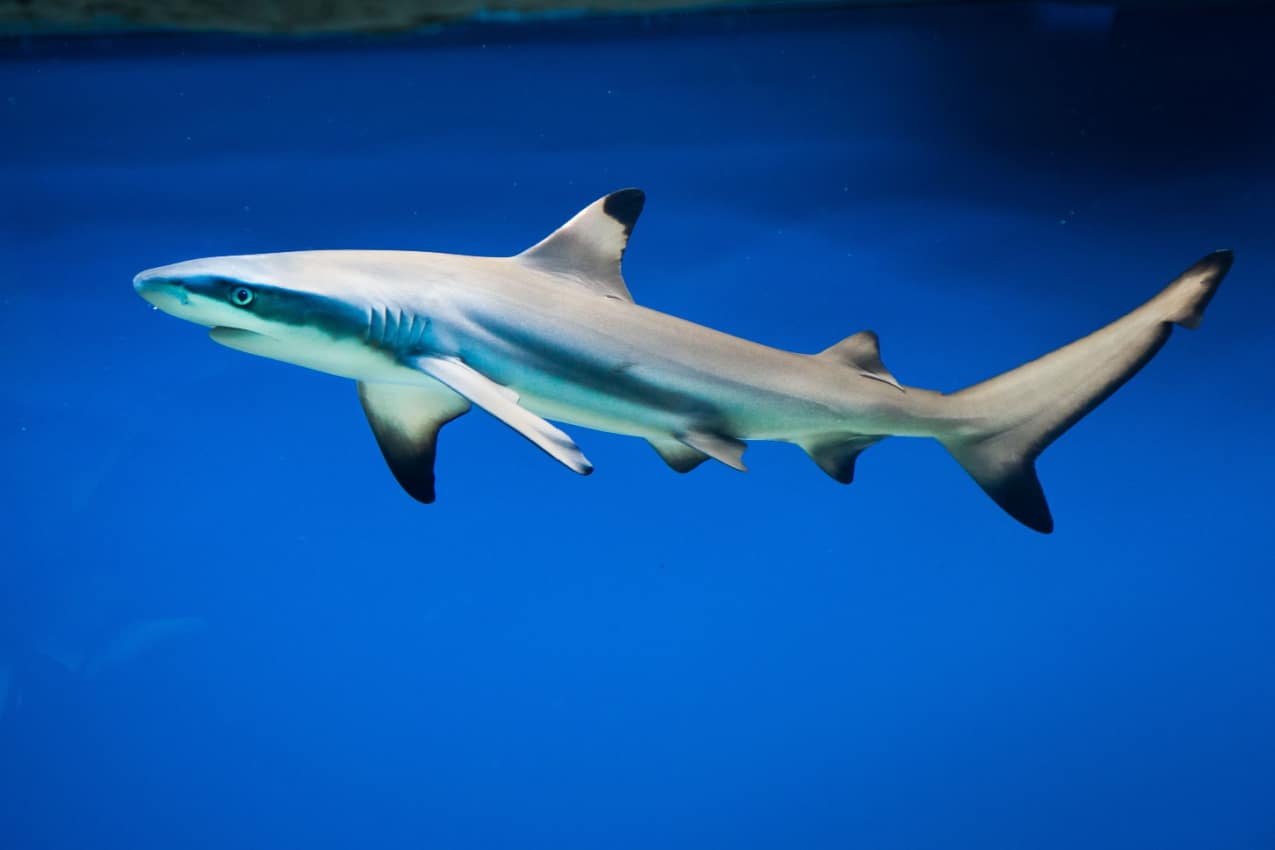
The blacktip sharks are unique and recognizable by their black-tipped fins, hence the name. They normally grow to be 5 to 8ft (1.5 to 2.4m) long, and while not the largest species, they’re very agile.
When they hunt or run from predators, they leap out of the water with their entire bodies into the air — it’s like watching an extravagant circus act in the middle of the ocean! They prey on fish, smaller sharks, and squid but rarely on humans. Blacktips are known to be shy unless provoked.
Whitetip Shark
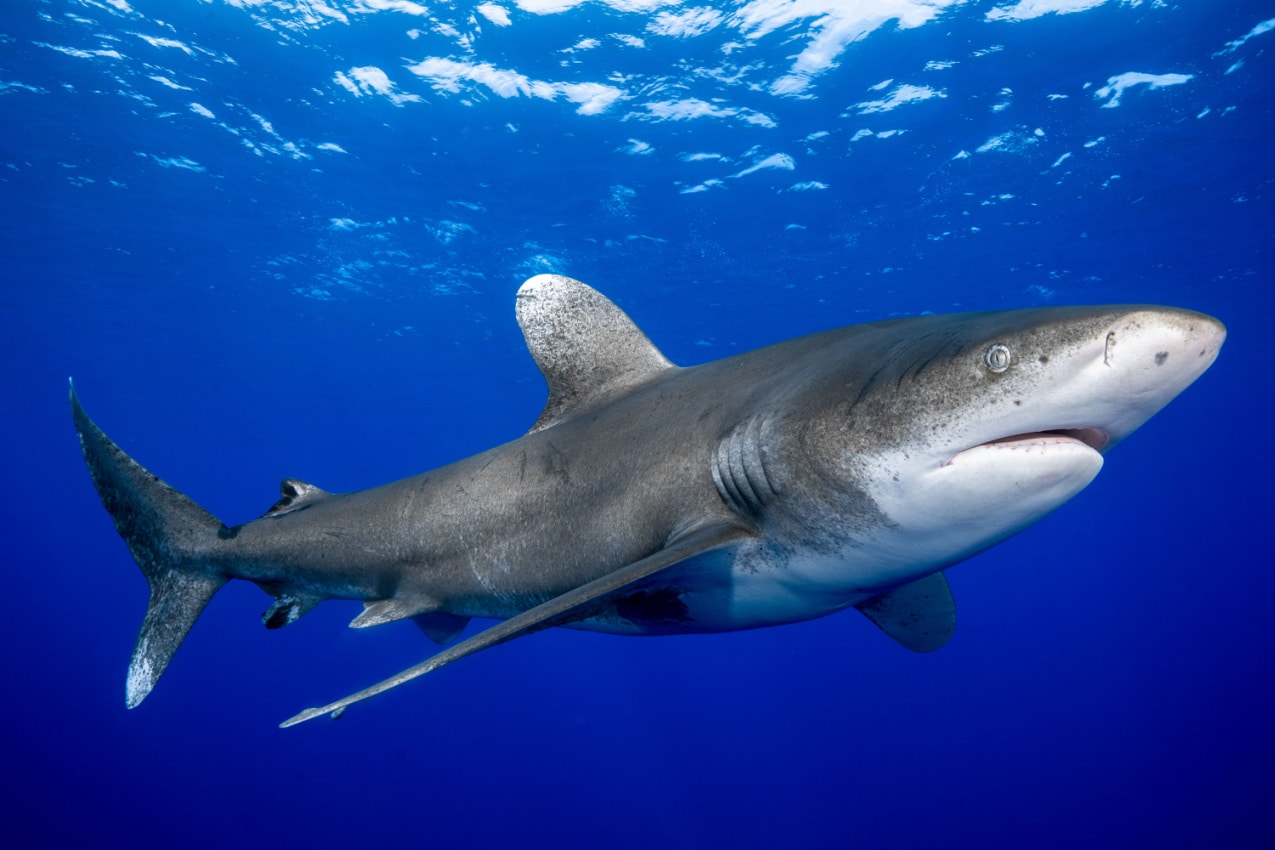
Whitetip sharks are nighttime hunters, as opposed to blacktips, the daytime acrobats.
Whitetips are also bigger, measuring up to 11ft (3.3m) in length. Their favorite foods are fish, octopus, and crab. They have a calm nature but sometimes approach divers underwater out of curiosity. Don’t worry, though, as they probably won’t bite — unless you’re made of fish, octopus, or crab!
Mako Shark
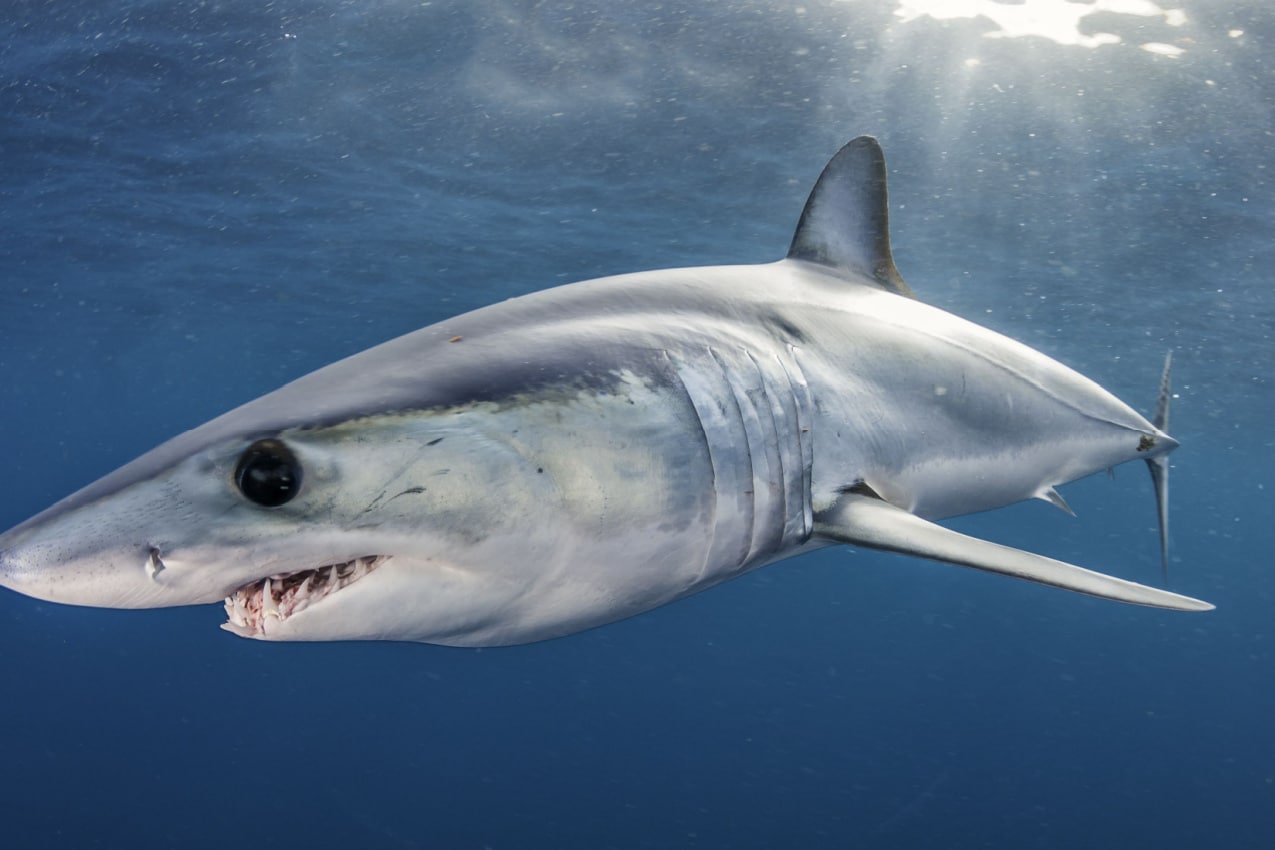
The mako shark is “the Flash” of the ocean, reaching a swimming speed of up to 45 mph (70 km/h). It’s also one terrifying-looking shark, with spikey teeth and eyes that can chill you to the bone.
There are two species of mako: shortfin and longfin. The shortfin is 13ft (3.9m) long, and the longfin is around 14ft (4.3m). They feed on fish, squid, and even small marine mammals. While they look ferocious, they aren’t hostile toward humans. They prefer the freedom of the open sea to pursue their favorite marine prey.
Nurse Shark
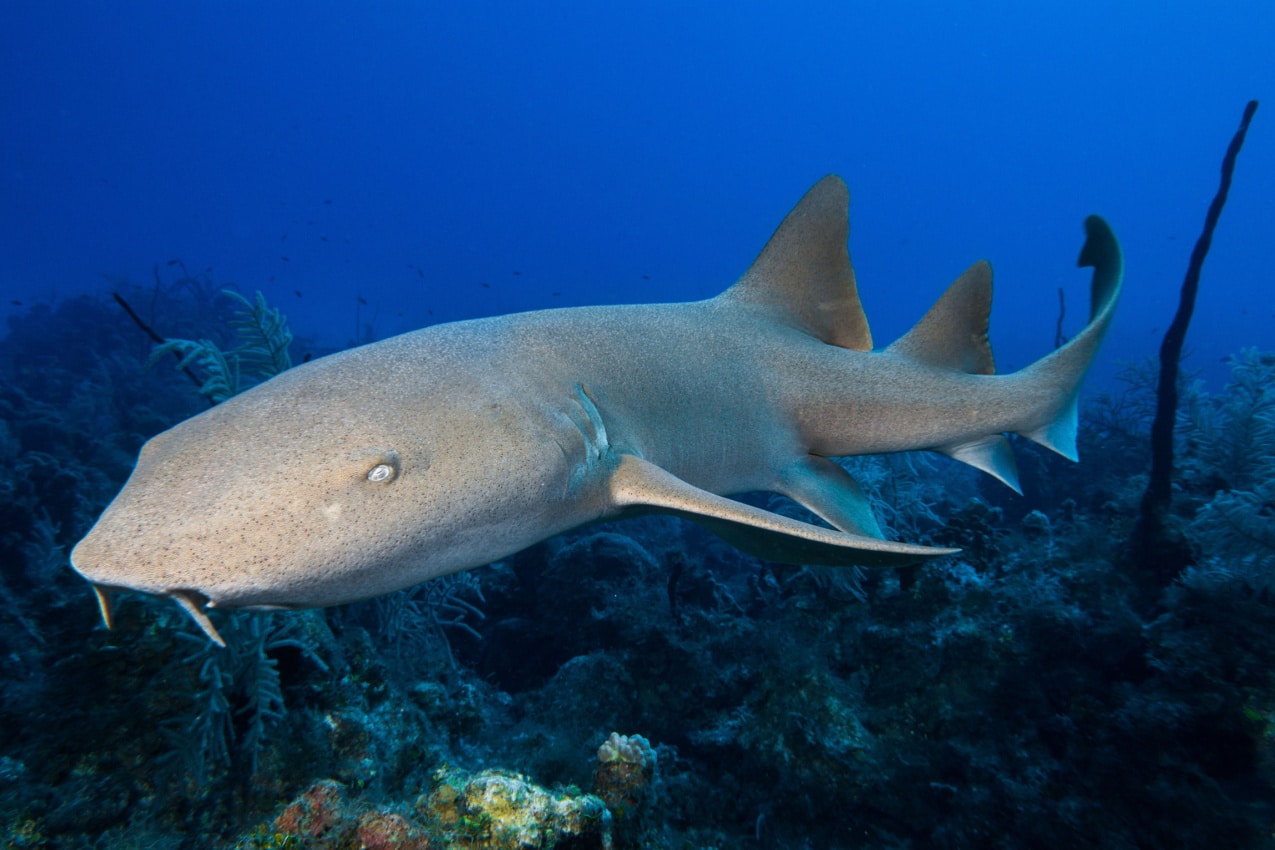
Nurse sharks are a gentle shark species. There are two theories on why they are called what they’re called: a) their eating sounds are similar to those of a nursing child, and b) their original name is “nusse.”
Nurse sharks have large heads, small eyes, and tiny teeth and grow up to 9ft (2.7m) long.
They are bottom dwellers, often relaxing on the ocean floor throughout the day and preying on fish, crabs, and mollusks at night. Nurse sharks are known for their peaceful, non-aggressive, and friendly nature, so they’re one of the more approachable shark species for divers.
Lemon Shark

When Mother Nature gives the ocean lemons, the ocean makes lemon sharks! Lemon sharks are an enthralling species recognized for their unique yellow-brownish color.
They are medium-sized sharks that can grow 10 feet (3m) long. You can spot them in their favorite habitat — the ocean mangroves and coral reefs, munching on fish, crabs, and, on rare occasions, tiny sharks and rays. Lemon sharks are typically non-aggressive, although they should be approached with caution, especially during diving or snorkeling.
Silky Shark
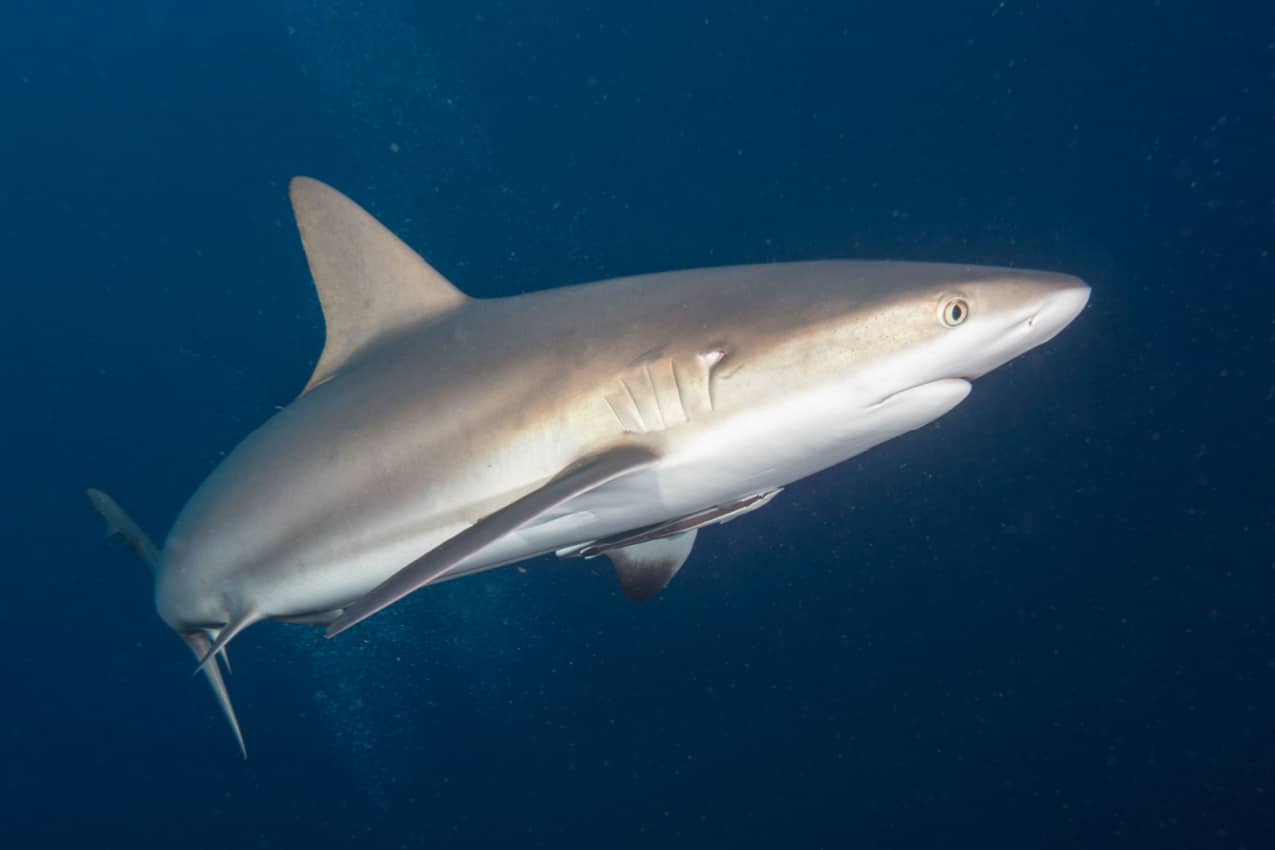
Silky sharks are named for their smooth and silky skin. They’re medium-sized sharks that can grow 11.4ft (3.5m) long.
Their diet consists mainly of fish, squids, and crustaceans. They are curious species, known to approach boats, divers, and daring explorers. But don’t worry; they’re generally non-aggressive.
Tiger Shark
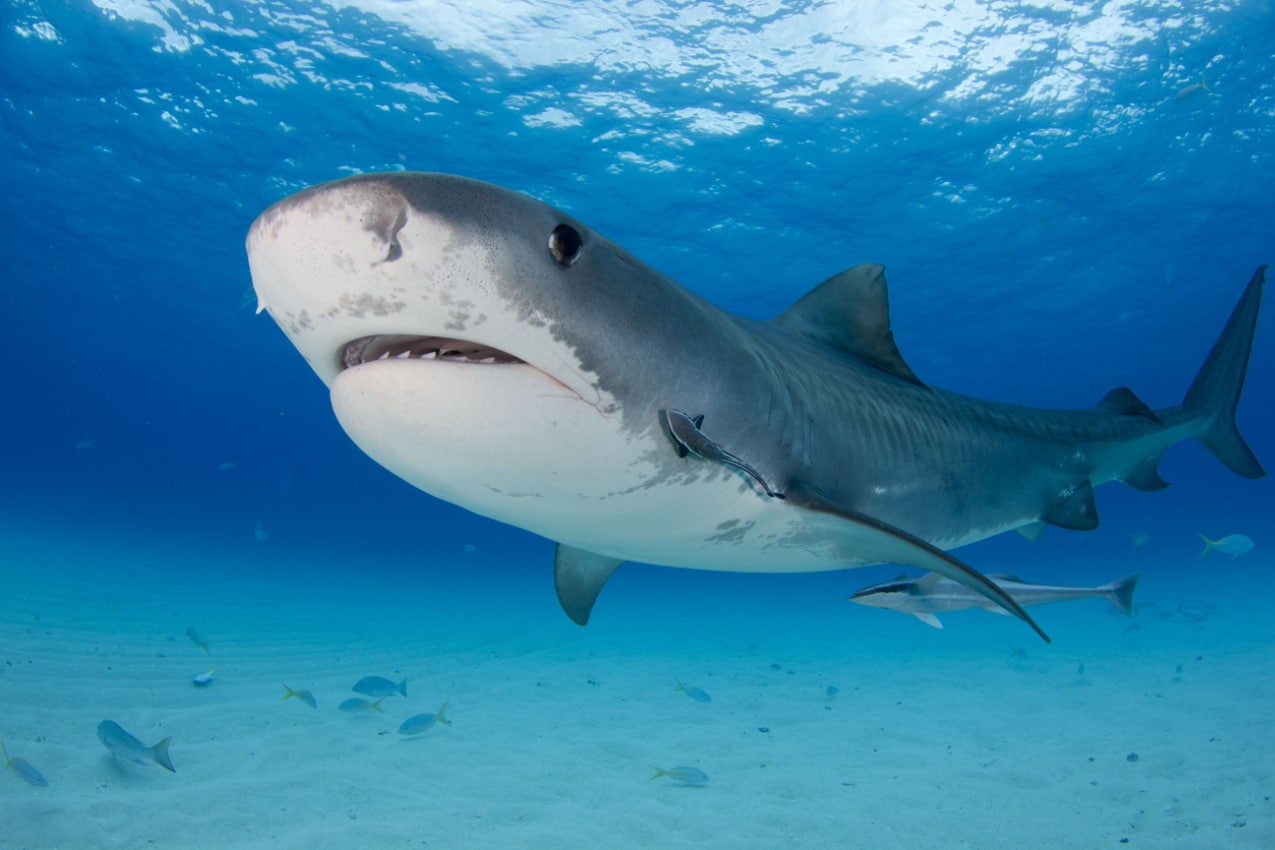
The tiger shark gets its name from the dark stripes on its body, which are very similar to those of a tiger. They’re a big species that can grow up to 14ft (4.3m) long and can be found everywhere, from shallow to deep waters.
Tiger sharks have earned the moniker “garbage cans of the sea” since they eat almost anything, including humans. As a result, this may be the first species on our list that you need to be very cautious of.
Like the great white shark, they are known to attack people, but unlike white sharks, which are known to bite and then swim away, tiger sharks are likely to eat the victim. Yes, they not only resemble tigers in their skin pattern but also in their viciousness.
Sandbar Shark
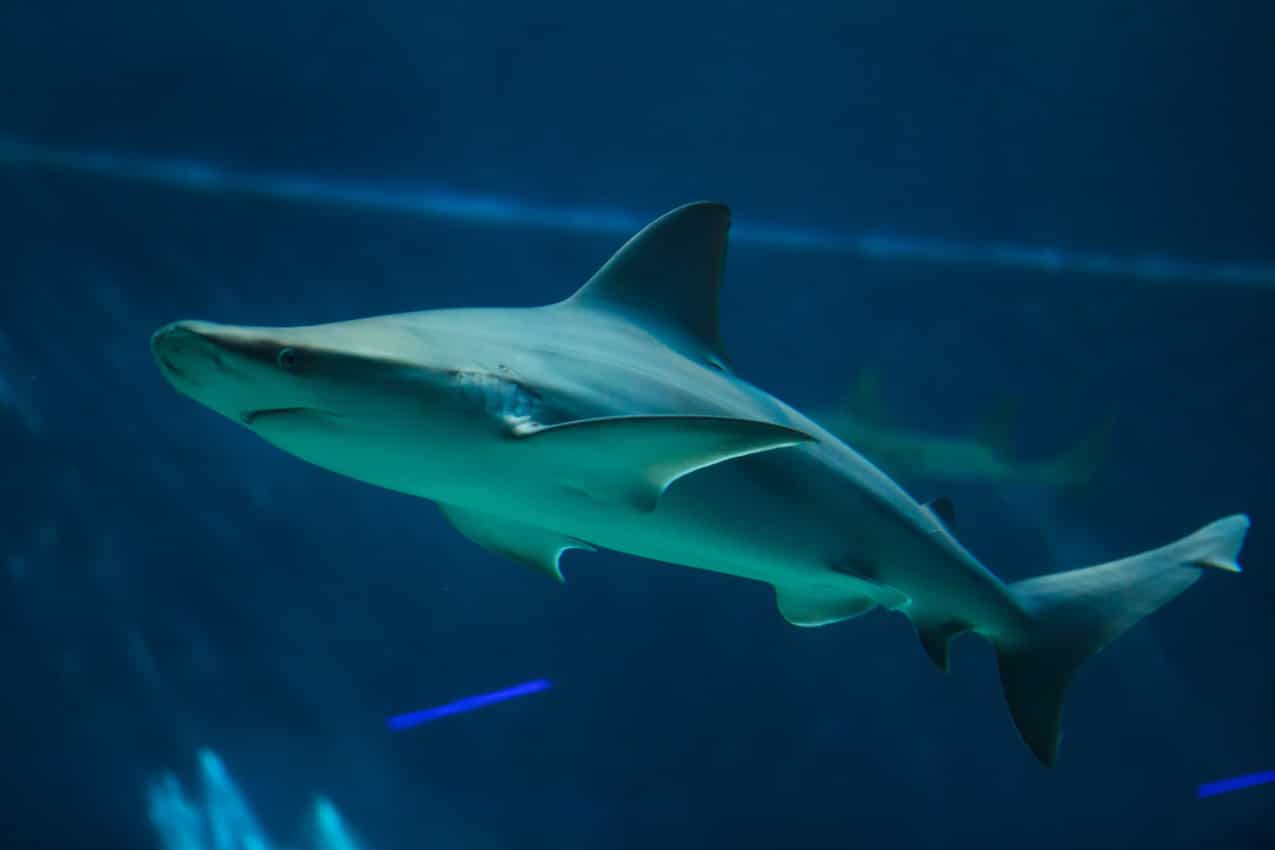
Sandbar sharks are the beach-goers of the Gulf of Mexico, as they love to unwind on the sand-covered ocean floor — hence their name.
They’re also easily identified thanks to their enormous dorsal top fin and the fact they’re one of the bigger coastal sharks, growing to a maximum length of 8ft (2.4m). The sandbar shark diet includes bony fish, rays, crustaceans, and sometimes small sharks.
They don’t like to swim in shallow areas and close to the ocean’s surface, so they pose little threat to humans.
Blacknose Shark
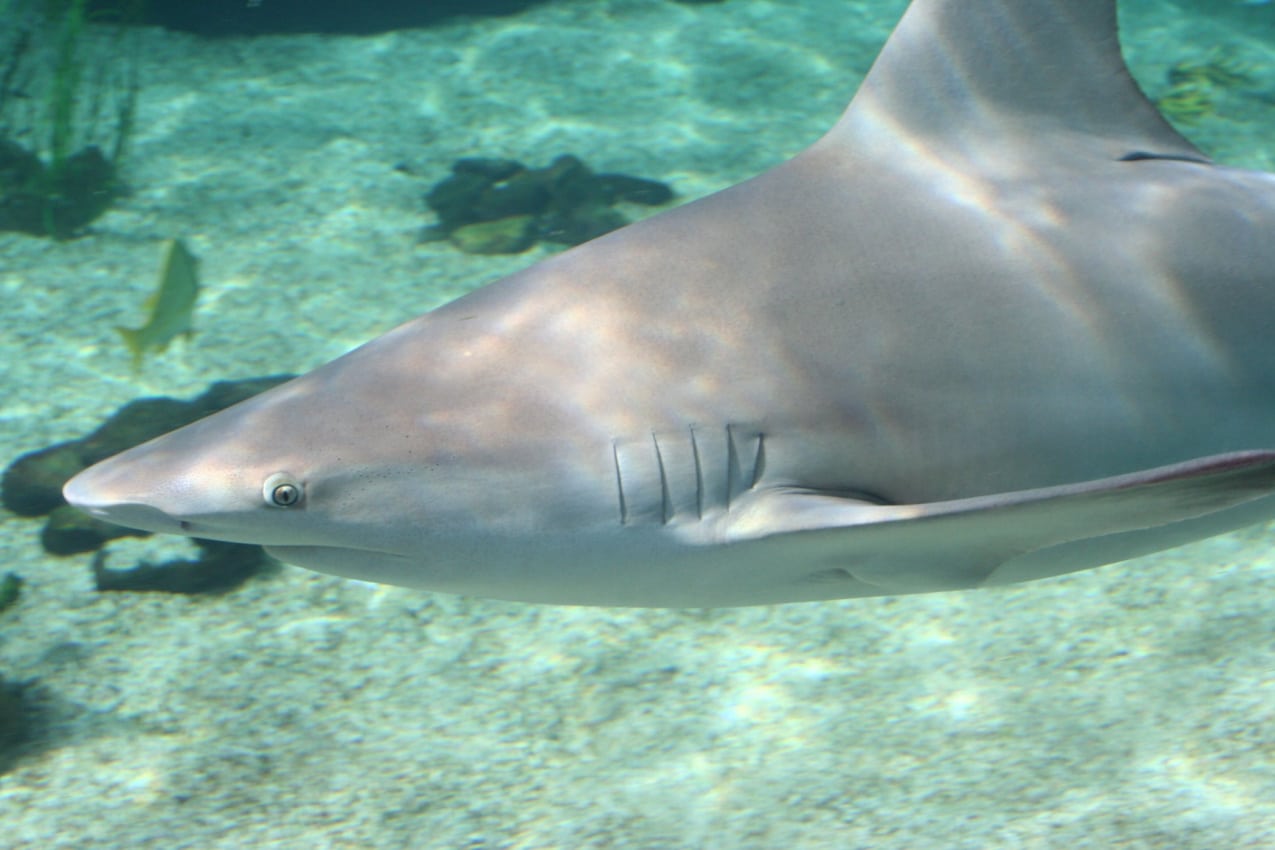
The blacknose sharks are a small shark species. Their name comes from the black mark on the tip of their nose, which clashes with their light body.
Blacknose sharks reach lengths of around 5ft (1.5m). They prefer to cruise in the shallows, so they’re typically found in bays, estuaries, and nearshore locations.
And what is their meal of choice? Small bony fish, crabs, but never humans — perhaps because we appear too big in their eyes. But don’t tempt them, as they could bite if provoked.
Finetooth Shark
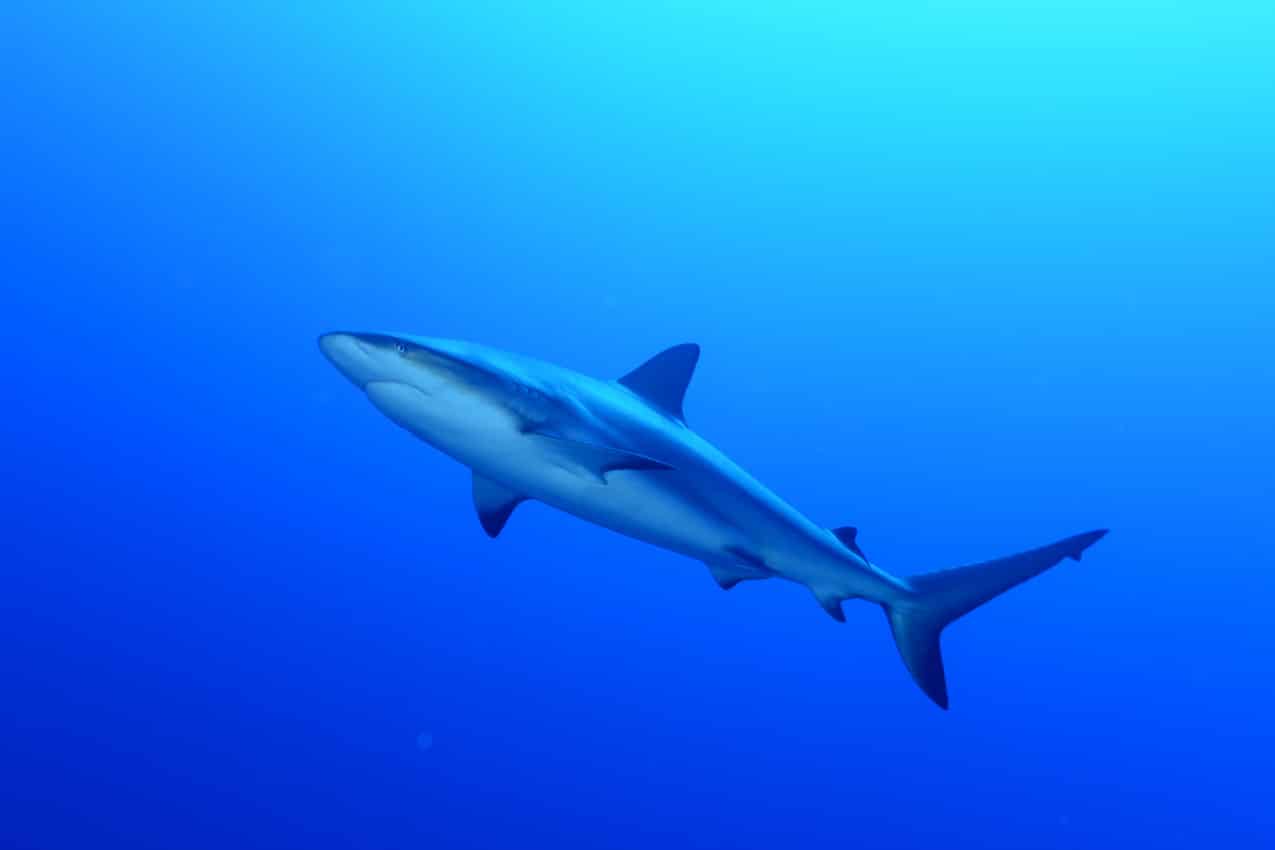
Finetooth sharks look like they could win the best shark teeth pageant of the Gulf — their teeth are narrow, pearly white, pointy, and smooth.
They’re medium-sized sharks, reaching up to 3 to 7.5ft (0.9 to 2.3m) in length, and have a slim physique. They’re most easily recognized by their extremely pointed snouts.
Finetooths favor shallow areas, so you may spot them along coastal locations like Cancun . However, they typically shy away from human interaction.
Smooth-Hound Shark
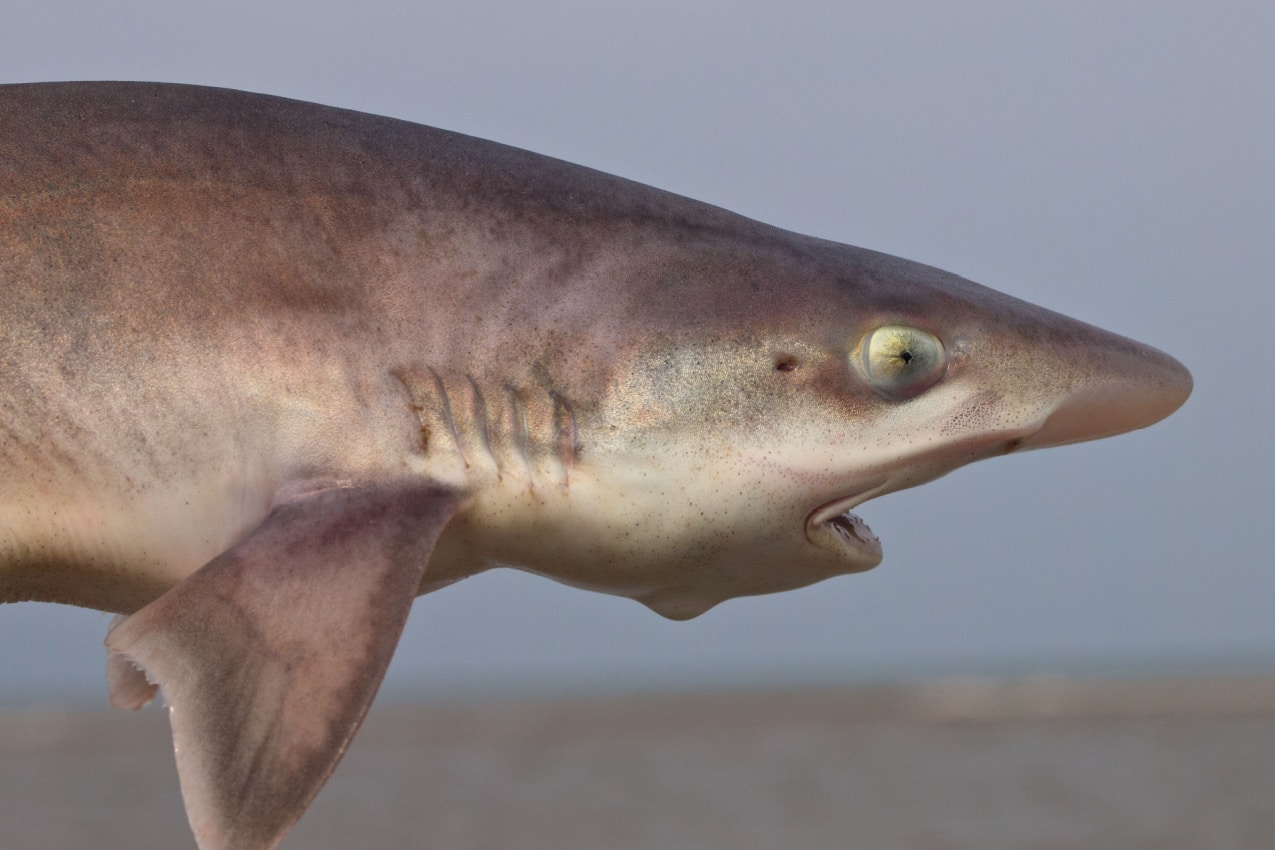
The smooth-hound shark is another species of the small shark family. They typically reach lengths of up to 5.3ft (1.6mm). Adorable!
Their bodies lack spiky scales, which gives their skin a silky texture, and they are easily discernible by their cat-like eyes.
Smooth-hound sharks like shallow coastal waters best, and their food is fairly similar to that of other smaller coastal sharks – fish, squids, crabs, and so on.
Caribbean Sharpnose Shark
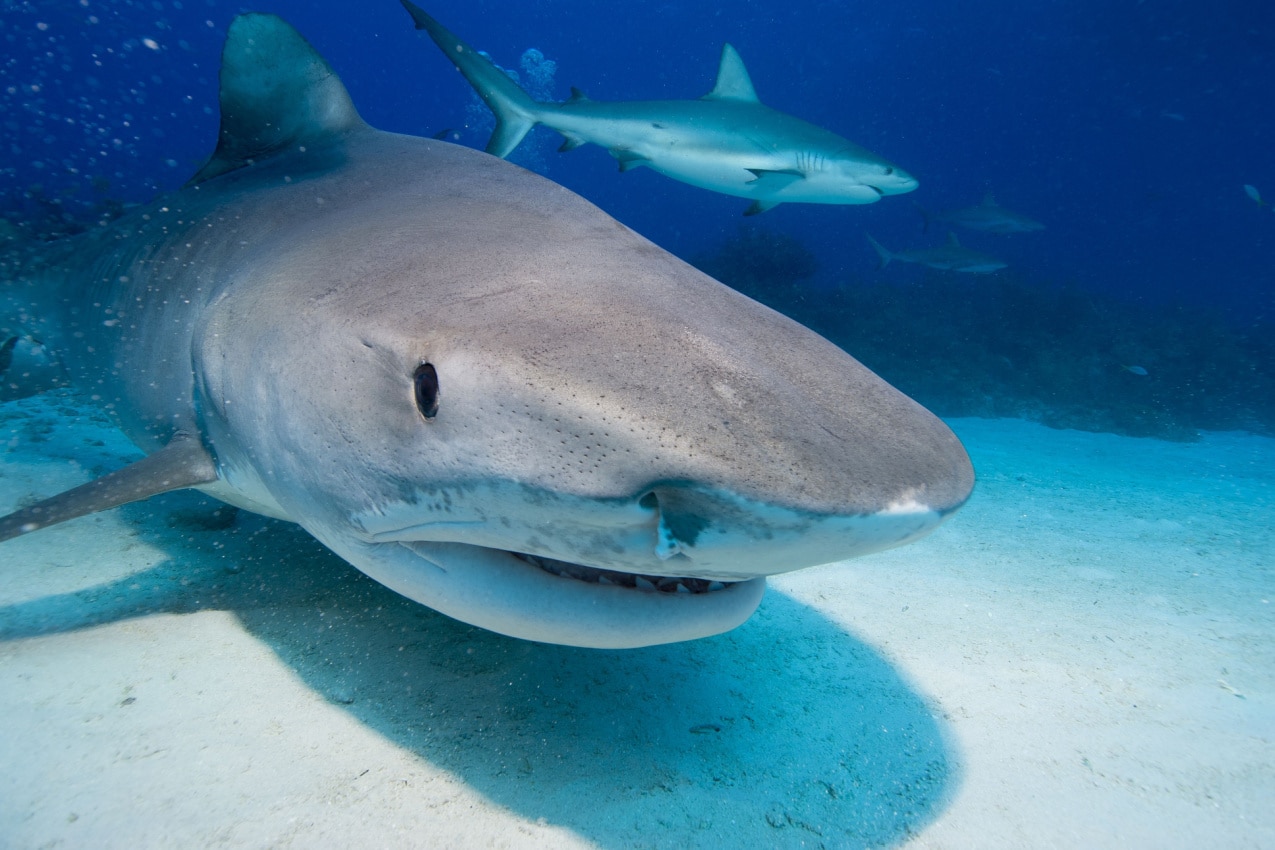
The Caribbean sharpnose sharks are named after, you guessed it — their super-pointed snouts! Another member of the short shark family, this species can grow to a maximum length of 2.3 feet (0.7 meters).
Like other small shark species, they frequent the bays, estuaries, and shallow coastal waters — and their diet is more or less the same.
Caribbean sharks, like all other tiny coastal sharks, aren’t aggressive or dangerous to humans unless you annoy them — then they may give you a sharp nose-bonk or, even worse, a bite on the toe.
Caribbean Reef Shark

Reef sharks, as the name suggests, typically swim along the colorful coral reefs of the Caribbean Sea, so if you’re on vacation in Playa Del Carmen or Cozumel, you might run into them when snorkeling or swimming.
But don’t panic, as these sharks, like nurse sharks, are one species that loves to hang out with divers and snorkelers. In the water, you can recognize them by their gray skin and white-tipped fins. They can grow pretty big, up to 10ft (3m) long. Their diet consists of shrimp, lobster, octopus, and squid — so they pretty much have a similar taste for seafood as us humans.
Galapagos Shark
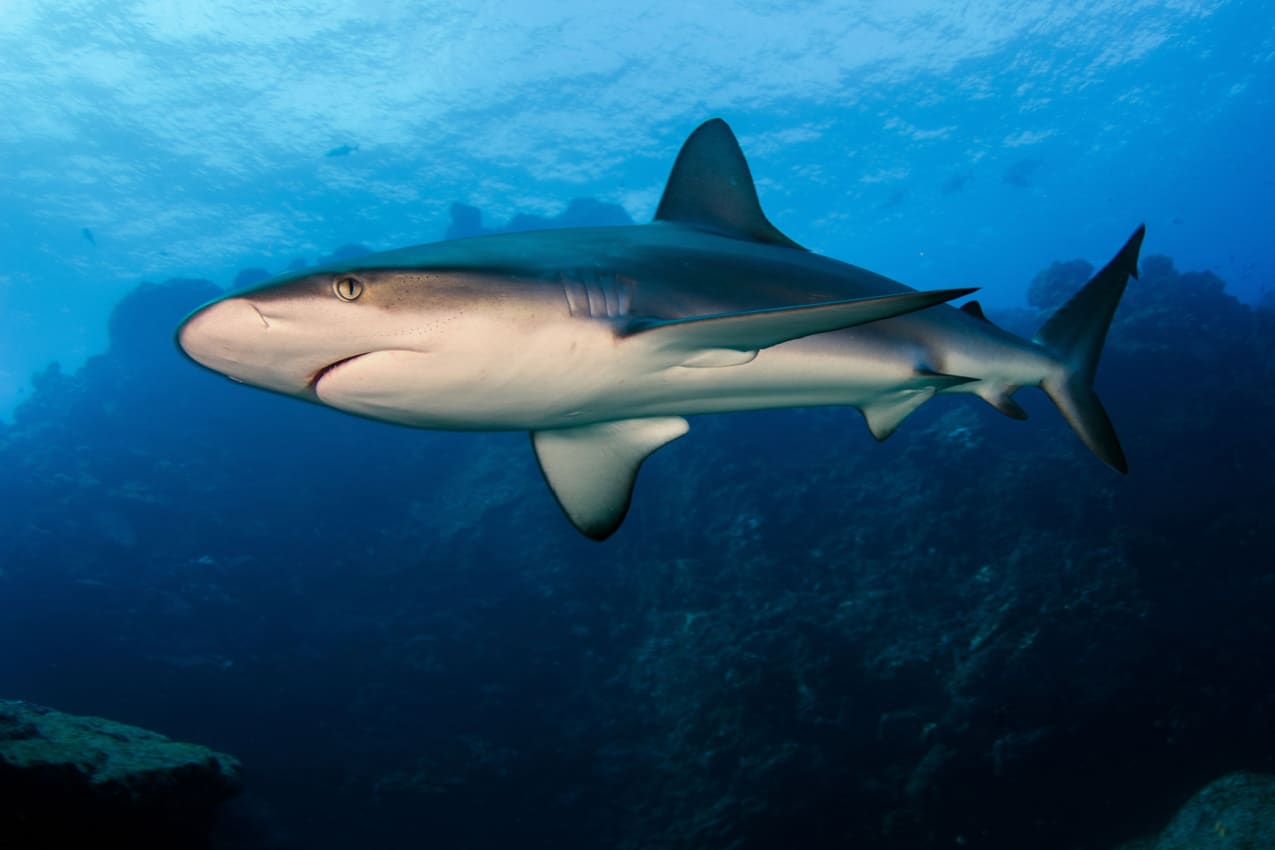
The Galapagos shark first emerged in the Galapagos Marine Reserve, but today, they are widespread because this species loves to travel!
Galapagos are exceptional navigators, covering distances of up to 1,240 miles (2,000 km). Impressive migrative skills, right? They’re also pretty big, growing up to 10ft (3m) long. They prefer to live in large groups and enjoy eating fish, squids, and octopuses, but they also hunt seals and sea lions.
When it comes to human interaction, they aren’t very accommodating. Galapagos is known to attack fishermen and snorkelers if they feel threatened. If you take a diving trip, you don’t want to have an encounter with this species.
Spotted Ragged-Tooth Shark

Boy, oh boy, how scary-looking is this next shark species? The name says it all — spotted ragged-tooth sharks have jaws with very pointy needle-like teeth. Plus, they have a hump-backed appearance that makes them bulkier and even more frightening than the average shark.
These sharks have one unique trait that sets them apart from other varieties — their habit of swallowing air. Yes, you heard it right. They swim to the surface to gulp air. This trick helps them remain motionless at any depth while hunting prey.
They’re big sharks that can grow to be 10 feet (3 meters) long. They prefer sandy shorelines and underwater reefs and feed primarily on fish, stingrays, and other sharks. If you see them, you’ll probably panic from how scary they look, but when it comes to your safety — they’re gentle creatures who don’t like to stick their needle-like fangs into human flesh.
Great White Shark

It’s time to meet the king of the ocean: the great white shark, one of the largest and most powerful predatory shark species!
Great whites are massive, reaching lengths of up to 20ft (6m). They’re bulky, with gray bodies and white bellies. Their taste in cuisine includes anything from whales, seals, sea lions, and other large fish. They have a unique hunting technique — they can propel themselves through water in sudden bursts of speed of up to 35mph (56kph).
They love to hunt in shallow places and on the ocean’s surface and are frequently seen around surfers. While they have been known to attack humans, they aren’t particularly drawn to human flesh. They may attack humans if they’re threatened or because they mistake a human for a marine animal, such as a seal or sea lion. Still, remain extremely cautious around this species. They are the true rulers of the sea, and we are merely visitors in their kingdom.
Spinner Shark
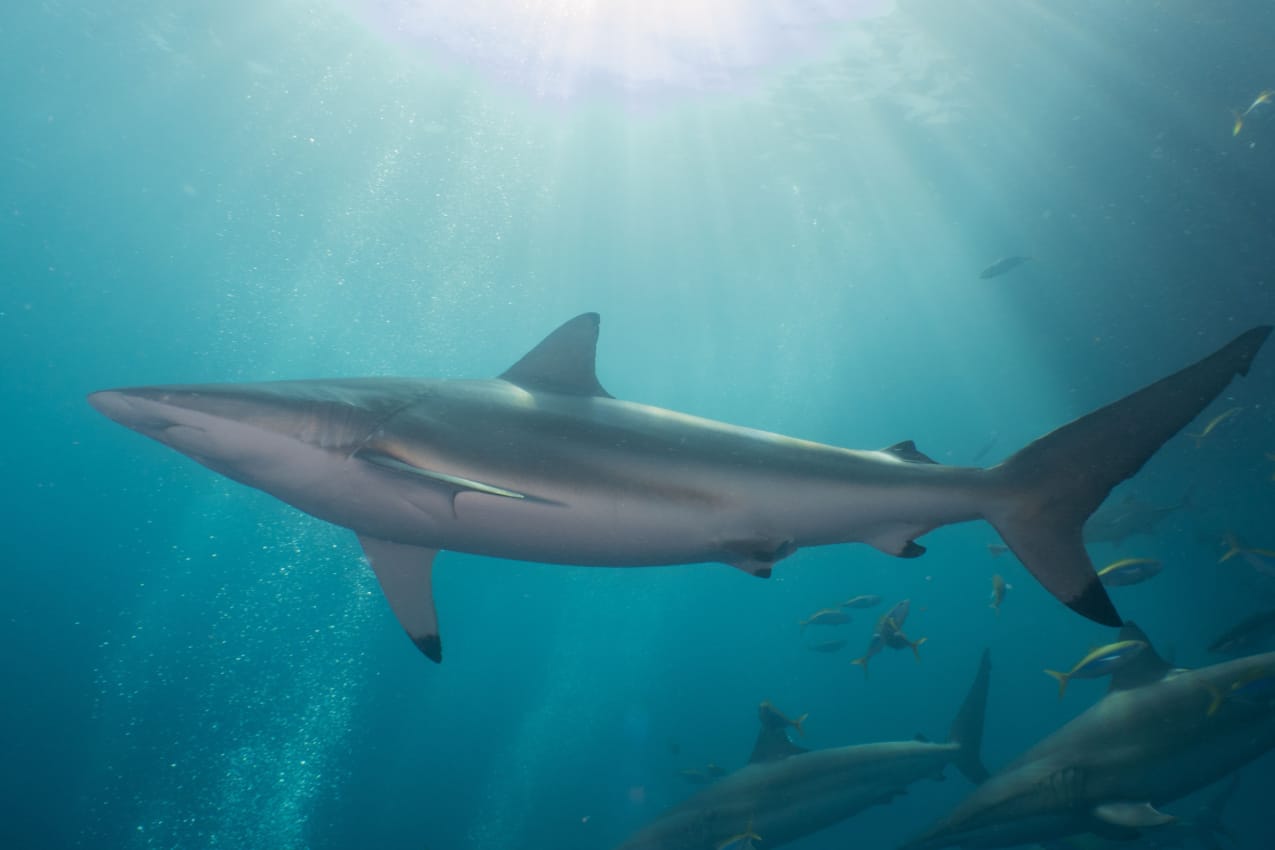
Spinner sharks are another acrobatic shark species — and if you ask us, they’re way better acrobats than the blacktip shark. As the name suggests, they like to jump out of the water and spin three times in the air.
Although a great spectacle for humans, their spins aren’t just for show. This is their unique way of catching prey. Spinners can grow to be 9ft (2.7m) long and have black tips on their frontal fins.
Their favorite delicacy is herring and sardine fish, and when it comes to humans, these sharks aren’t aggressive — probably because we are too heavy for them to spin into the air.
Blue Shark
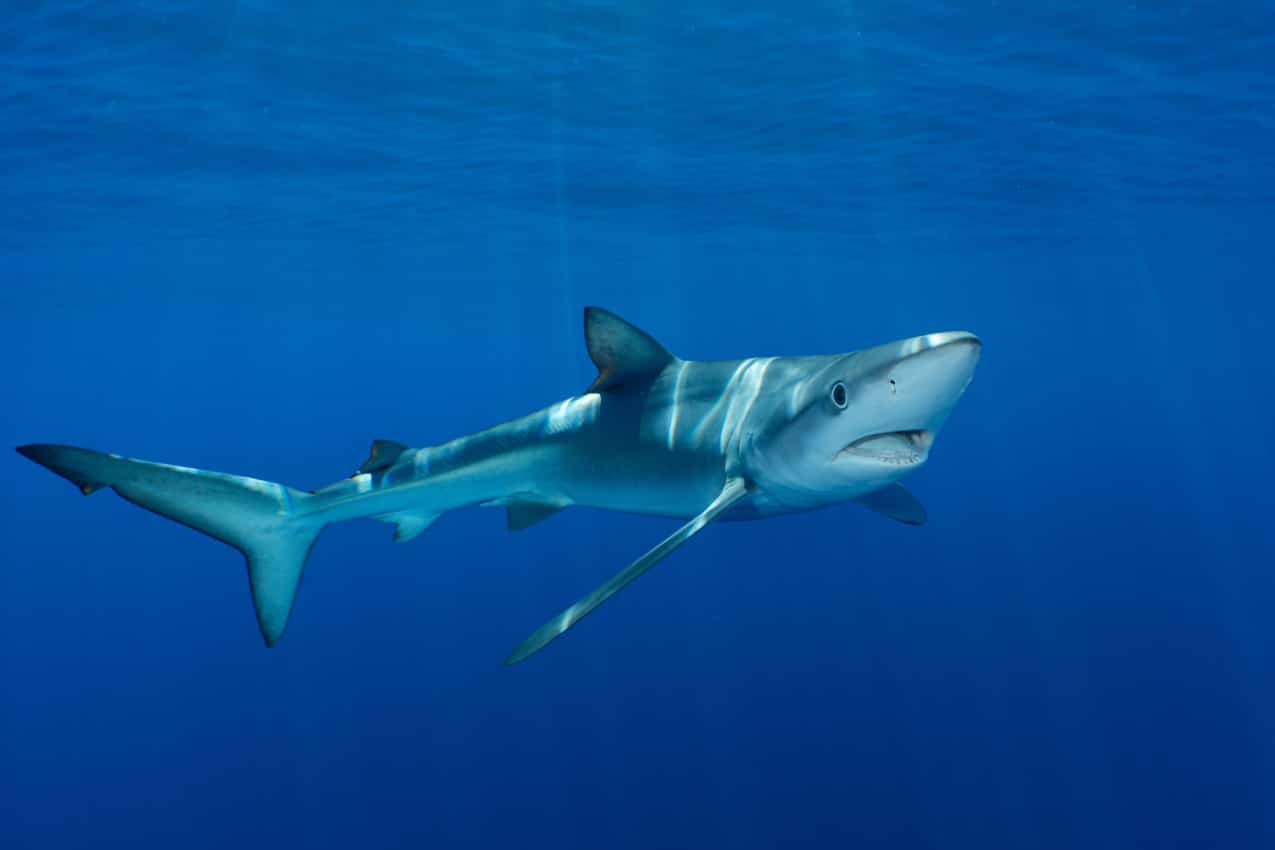
Why did the blue shark feel so blue? Because it couldn’t find other species with the same enchanting hue! Just kidding, the name of this species actually has to do with its appealing and unique blue skin color.
Blue sharks can grow to be 13ft (3.9m) long. They are fast, agile swimmers who migrate over 9,000km (5,700+ miles) per year! Their menu comprises tiny fish, squid, and other marine organisms.
Blue sharks are curious and may approach you when snorkeling or diving, so exercise caution.
Dusky Shark
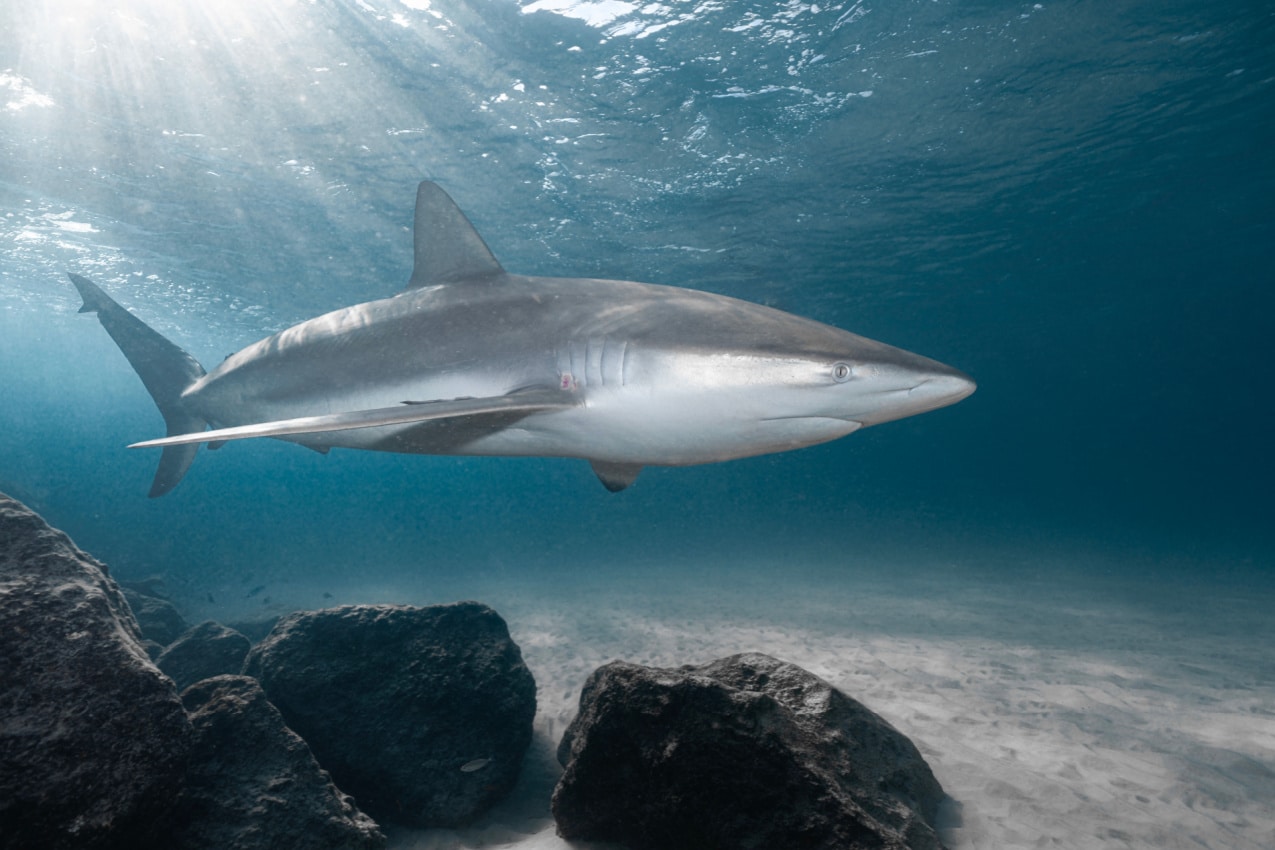
Dusky sharks resemble shadows flickering beneath the waters. Their bodies are grayish-brown, which helps them blend in with their deepwater habitats.
Aside from their skin color, duskies are distinguished by their big first and second dorsal fins. They grow up to 12 ft (3.6m) long and, like blue sharks, practice long-distance migrations.
Their primary diet comprises bony fish, squid, and occasionally smaller sharks and rays. They have been known to enter shallow waters on occasion, and they may be frightening to humans because of their size. Caution is advised.
Whale Shark
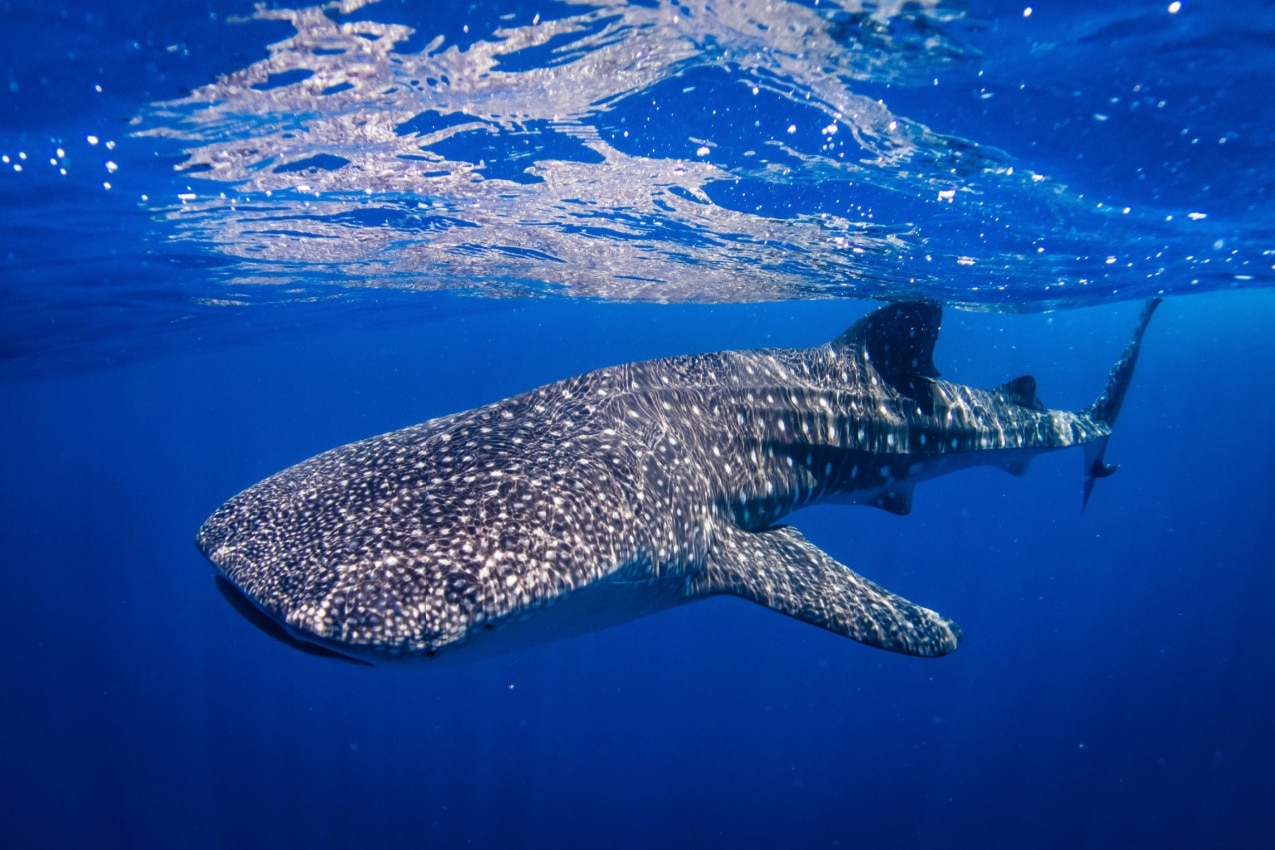
The time has come to meet our favorite creatures in the Gulf of Mexico — the wondrous whale sharks. These creatures look like Mother Nature has put the whole sky of stars onto their bodies, making them one of the most magical beings to roam the oceans.
The whale shark is the biggest shark in the world, reaching lengths of 60ft (18m). But despite their size, they’re the most gentle sea creatures and have never been known to harm people. Yay! If you go on a snorkeling expedition, remember that they may accidentally bump you as they swim with you.
But, at the end of the day, they’re gigantic and make big movements in the water, so let’s be thankful that they don’t bite.
Basking Shark
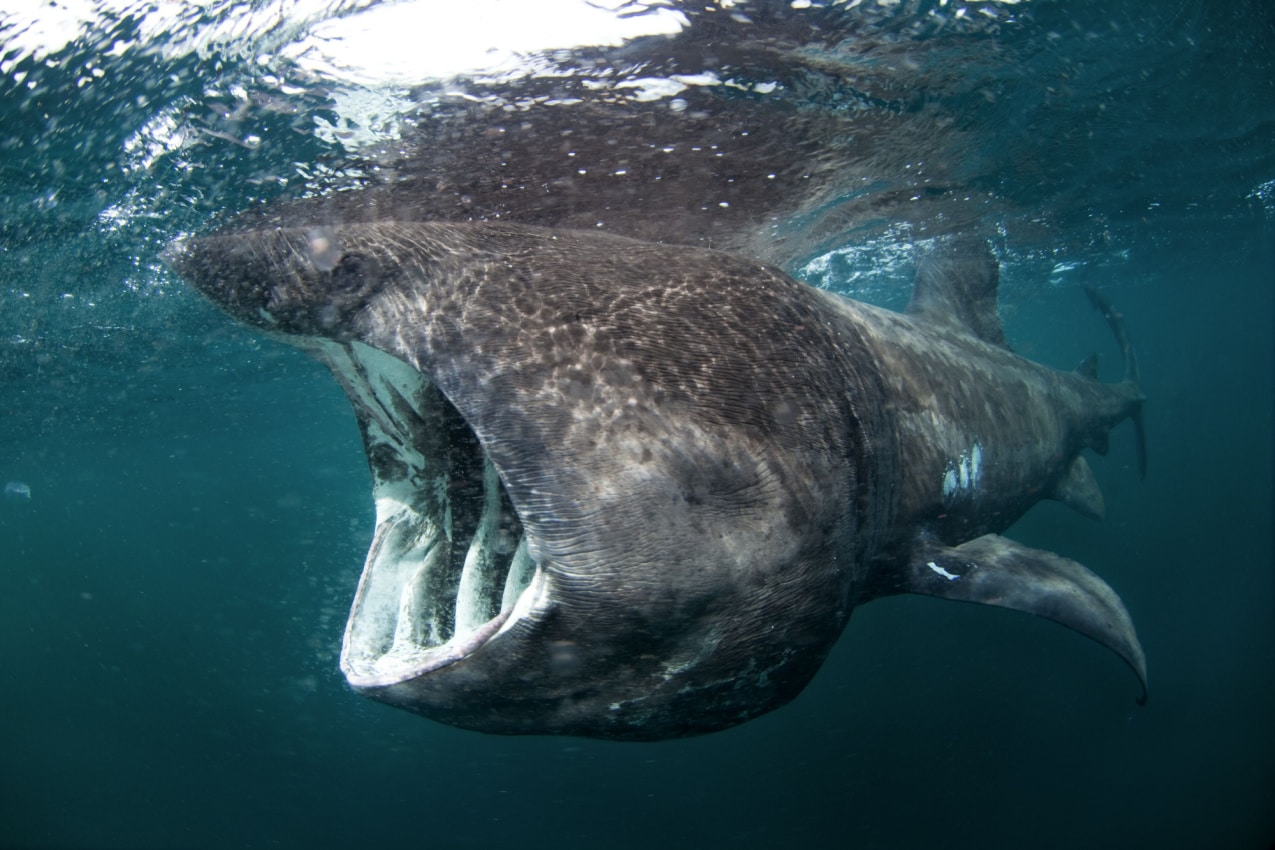
The basking shark is the second-largest fish species in the world after the whale shark. They are another gentle giant that roams the Gulf of Mexico.
Basking sharks reach lengths of up to 26ft (8 meters), and if you look at them, they resemble an ancient creature from the dinosaur era, grayish-brown in color and with skin that seems wrinkled.
Their mouth can open up to 3ft wide — a trait unique only to this species. Yup, they do look very frightening on the outside, but luckily, they come in peace, so feel free to pet them if they curiously approach your boat to say hello!
Greenland Shark
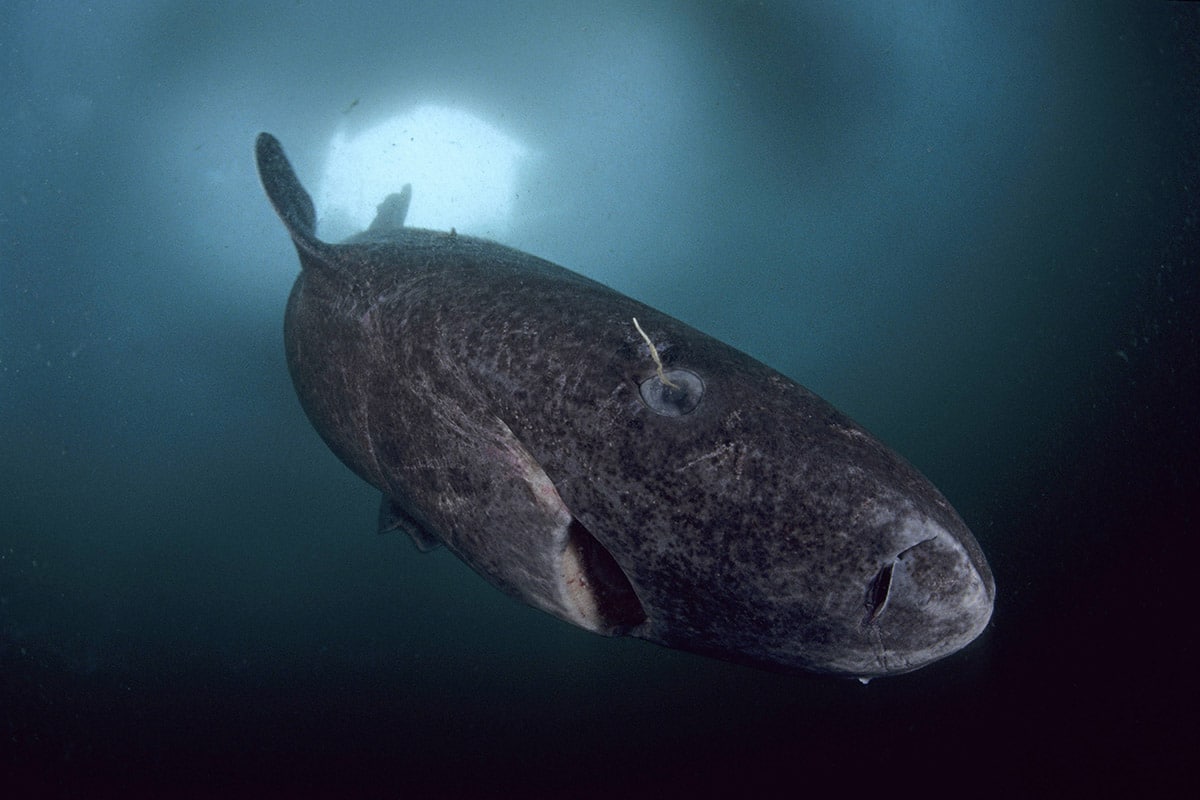
We end our list with the third biggest shark in the Gulf of Mexico and probably the most mysterious one — the Greenland shark. Interesting name for the Gulf, isn’t it? Well, their home is actually right around Greenland, in the cold waters of the North Atlantic and Arctic oceans.
Their ideal temperature is around 4.12°C, the temperature at which the species was discovered in the Gulf of Mexico. They have a distinct black hue, rusty-looking skin, and small, captivating blue eyes. Greenlands can grow to be 24ft (7.3m) long and are thought to be the longest-living vertebrates known on Earth.
A lot about the biology and behavior of Greenlands is still unknown, and they are difficult to research due to their migratory tendencies and cold, deep-water habitats. Although they are very old, it’s astonishing how little is actually known about them.
The Unmatched Predators of the Deep: What Elevates Sharks to the Top of the Food Chain?
Sharks are apex predators, meaning they are at the very peak of the food chain, with no other predators willing to kill them for food.
Their outstanding survival skills have made them evolve into true rulers of the deep blue. For example, they’re known to have a potent sense of scent, which allows them to pinpoint injured marine animals from up to a quarter of a mile (1,320ft) away.
They are also masters at underwater hearing. They can detect disturbances in the water up to 800ft away (243m) with sounds ranging from 10 to 800 Hertz. Lower Hertz levels correspond to lower-pitched sounds, so sharks can pick up on quieter sound frequencies than us, humans. For context, people can hear sounds at frequencies ranging from 25 to 16,000 Hertz.
A shark can also detect movement up to 82 ft (25m) away. They can see in practically all directions since their eyes are on the side of their skull. Plus, they can see in the dark and can easily pinpoint reflecting or high-contrast shapes as potential prey.
Sharks can sense electricity generated by contracting muscles, such as those in the heart. These senses are positioned in their snouts and are so powerful that they can detect a prey’s beating heart, even if that prey is hidden beneath the ocean floor.
Sharks are indeed formidable predators, but they contribute to a healthy ocean environment. Before you label them as villains, keep in mind that their feeding balances the marine population. Plus, they eat sick and injured animals, which contributes to the well-being of the ocean ecosystem. See? They aren’t the bad guys, after all.
Are Sharks in the Gulf of Mexico Dangerous?
No, dangerous shark encounters are quite rare in the Gulf of Mexico, and we have the records to prove it. From 1907 all the way to 2023, there have been only 16 unprovoked shark attacks in the Gulf of Mexico. However, there are many shark species calling this place their home, so there’s a good possibility you’ll see some of them!
What You Can Do to Prevent a Shark Encounter in the Gulf of Mexico
- Sharks like to approach isolated prey, so don’t swim out alone while at sea
- Don’t stray too far from the shore
- Don’t go sunset or nighttime swimming — sharks hunt during low light hours and at night
- Stay out of the water if you have an open wound or are menstruating
- Shiny jewelry or reflective swimwear resemble fish scales and may attract a shark
- Excessive splashing may alert sharks that there is an injured animal nearby
- The most sensitive areas of a shark are its eyes, gills, and snouts — aim for those in the middle of an attack
Conclusion
If you’re traveling to the Gulf of Mexico, you should expect to see sharks. After all, it’s their home, and we are the guests — so we need to give them their space and respect them for their role as apex predators.
If you encounter a shark, get out of the water right away. If you hear that there’s a shark on the beach where you are, we would also advise you to stay away from the water for one or two days. If there is a shark in the vicinity, it may be looking for potential prey or smelling a wounded animal.
Have a safe trip!



